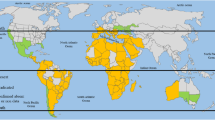Abstract
Laboratory and greenhouse studies were conducted to investigate the suitability of 2 hymenopterous parasites,Diadegma eucerophaga Horstmann andApanteles plutellae Kurdjumov for introduction to control diamondback moth (DBM),Plutella xylostella (L.), a destructive pest of crucifers in tropical to subtropical Southeast Asia. Parasitism byD. eucerophaga was high at temperature range of 15°C to 25°C and that ofA. plutellae, at 20°C to 35°C. Both parasites were active in searching for host and oviposited only during photophase. No parasitism was observed during darkness. WhereasA. plutellae could parasitize all instars of DBM larvae,D. eucerophaga parasitized only the first 3 instars and failed to parasitize the 4th. Parasitism byD. eucerophaga was greater when DBM larvae were feeding on common cabbage (Brassica oleracea var.capitata L.), than on cauliflower (B. oleracea var.italica L.), broccoli (B. oleracea var.botrytis L.) or Chinese cabbage [Brassica campestris L. ssp.pekinensis (Lour) Olsson].A. plutellae parasitism was greater when DBM larvac were feeding on Chinese cabbage than on common cabbage, cauliflower or broccoli. Storage of pupae at 0°C and 4°C to 6°C for up to 2 weeks reduced emergence ofD. eucerophaga adults more than that ofA. plutellae. A non-selective insecticide, deltamethrin, was toxic to adults of both parasites but selective ones such asBacillus thuringiensis, teflubenzuron, and pirimicarb were not. Pupae were more tolerant than adults to insecticides. The insecticide-resistant Luchu strain and susceptible laboratory strain of DBM suffered an equal level of parasitism by both parasites.
Résumé
Des études en laboratoire et en serre on été menées pour connaître l'aptitude de 2 hyménoptères parasites,Diadegma eucerophaga Horstmann etApanteles plutellae Kurdjumov en vue de leur introduction dans la lutte contre la fausse teignePlutella xylostella (L.), ravageur des crucifères dans la partie tropicale et subtropicale de l'Asie du Sud-Est. Le parasitisme parD. eucerophaga était élevé dans la gamme de températures de 15 à 25°C et celui dû àA. plutellae entre 20 et 35°C. Les 2 parasites étaient actifs dans la recherche de leur hôte et pondaient uniquement au cours de la photophase. On n'observait pas de parasitisme à l'obscurité. Tandis qu'A. plutellae pouvait parasiter tous les stades larvaires de la teigne,D. eucerophaga parasitait les 3 premiers states uniquement et échouait vis-à-vis du 4e. Le parasitisme parD. eucerophaga était plus important quand les larves de la teigne se nourrissaient de chou commun (Brassica oleracea var.capitata L.) plutôt que de chou-fleur (B. oleracea var.italica L.), de broccoli (B. oleracea var.botrytis L.) ou de chou chinois (Brassica campestris L. ssp.pekinensis (Lour) Olsson). Le parasitisme parA. plutellae était plus élevé quand les larves de teigne se nourrissaient de chou chinois plutôt que de chou commun, de chou-fleur ou de broccoli. Le stockage de pupes à 0°C et de 4°C à 6°C jusqu'à 2 semaines réduisait l'émergence des adultes deD. eucerophaga plus que celle des adultes d'A. plutellae. Un insecticide non sélectif, la deltaméthrine était toxique pour les adultes des 2 parasites, mais les sélectifs, tels que leBacillus thuringiensis, le téflubenzuron et le pirimicarbe ne l'étaient pas. Les pupes étaient plus tolérantes que les adultes aux insecticides. La lignée Luchu résistante aux insecticides et la lignée de teigne de laboratoire, sensible, manifestaient un égal niveau de parasitisme de la part des 2 parasites.
Similar content being viewed by others
References
AVRDC — 1987. 1985 Progress Report —Asian Veg. Res. Dev. Cent., Shanhua, Taiwan, 471 pp.
Cheng, E. Y. — 1986. The resistance, cross resistance, and chemical control of diamondback moth in Taiwan. In: Diamondback Moth Management — Proc. 1st Intern. Workshop (N. S. Talekar & T. D. Griggs, eds). —Asian Veg. Res. Dev. Cent., Shanhua, Taiwan, 329–345.
Cheng, E. Y. — 1988. Problems of control of insecticide-resistantPlutella xylostella. —Pestic. Sci., 23, 177–188.
Duncan, D. B. — 1955. Multiple range and multipleF tests. —Biometrics, 11, 1–42.
Ho, K. K. — 1979. Studies on the effect of low temperature storage ofApanteles plutellae. —NTU Phytopathol. Entomol., 6, 16–22.
Liu, M. Y., Tzeng, Y. J. &Sun, C. N. — 1982. Insecticide resistance in the diamondback moth. —J. Econ. Entomol., 75, 153–155.
Mani, M. &Krishnamoorthy, A. — 1984. Toxicity of some insecticides toApanteles plutellae, a parasite of the diamondback moth. —Trop. Pest Manage., 30, 130–132.
Miyata, T., Saito, T. &Noppun, V. — 1986. Studies on the mechanism of diamondback moth resistance to insecticides. In: Diamondback Moth Management — Proc. 1st Intern. Workshop, (N. S. Talekar &T. D. Griggs eds) —Asian Veg. Res. Dev. Cent., Shanhua, Taiwan, 347–357.
Sastrosiswodo, S. &Sastrodihardjo, S. — 1986., Status of biological control of diamondback moth by introduction of parasitoidDiadegma eucerophaga in Indonesia. In. Diamondback Moth Management — Proc. 1st Intern. Symp.; (N. S. Talekar &T. D. Griggs eds). —Asian Veg. Res. Dev. Cent., Shanhua, Taiwan, 185–194.
Sun, C. N., Wu, T. K., Chen, J. S. &Lee, W. T. — 1986. Insecticide resistance in diamondback moth. In: Diamondback Moth Management — Proc. 1st Intern. Workshop. (N. S. Talekar &T. D. Griggs eds) —Asian Veg. Res. Dev. Cent., Shanhua, Taiwan, 359–371.
Talekar, N. S. — 1988. Biological control of diamondback moth on farmers' fields. In: Gardening Nutritious Vegetables. —Asian Veg. Res. Dev. Cent., Shanhua, Taiwan, 50–54.
Velasco, L. R. I. — 1983. Field parasitism ofApanteles plutellae Kurdj. [Braconidae, Hymenoptera] on the diamondback moth of cabbage. —Philipp. Entomol., 6, 539–553.
Vos, H. C. C. A. A. — 1953. Introduction in Indonesia ofAngitia cerophaga Grav., a parasite ofPlutella maculipennis Curt. —Contr. Cen. Agric. Res. Sta., Bogor, No. 134.
Author information
Authors and Affiliations
Rights and permissions
About this article
Cite this article
Talekar, N.S., Yang, J.C. Characteristic of parasitism of diamondback moth by two larval parasites. Entomophaga 36, 95–104 (1991). https://doi.org/10.1007/BF02374640
Received:
Accepted:
Issue Date:
DOI: https://doi.org/10.1007/BF02374640




